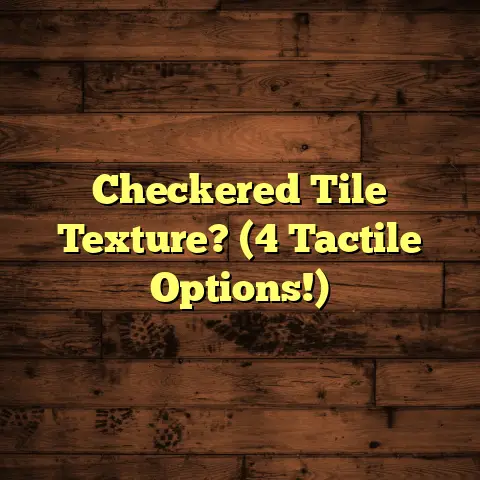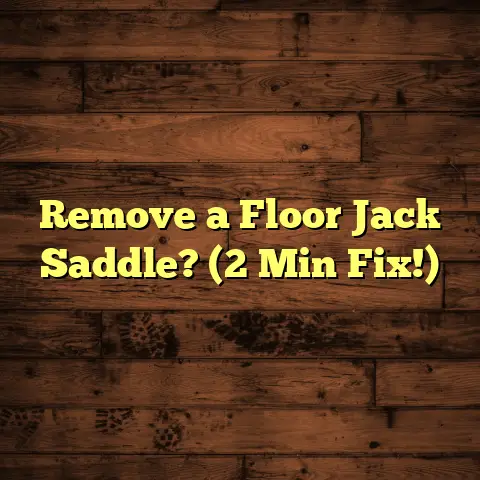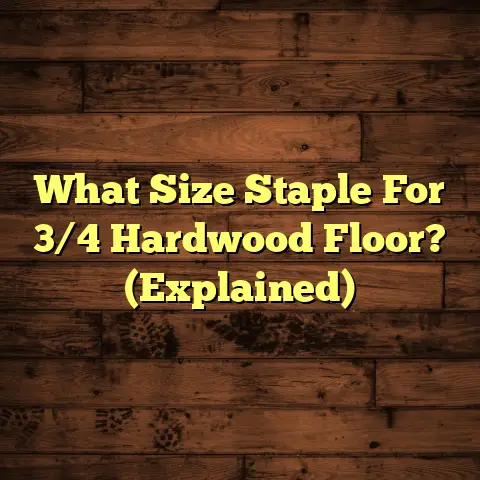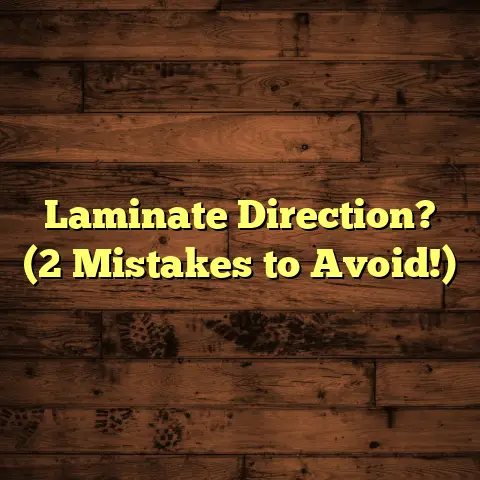Republic Vinyl Plank: Quality & Durability? (5 Flaws!)
These days, everyone’s looking for ways to make their homes more energy-efficient.
And let’s be honest, who doesn’t want to save a few bucks on those hefty energy bills?
Flooring plays a bigger role than you might think!
Vinyl plank flooring, in particular, has become a super popular choice.
Why?
Well, it looks great, it’s relatively affordable, and many claim it can even help with energy savings.
Think about it: a well-insulated floor helps keep the heat in during winter and the cool air in during summer.
This means your HVAC system doesn’t have to work as hard, and you save energy.
One brand that keeps popping up in conversations is Republic Vinyl Plank.
They’ve built a reputation for offering a blend of aesthetics and practicality.
But is it really all it’s cracked up to be?
That’s what we’re diving into today.
I’m going to give you my honest take on Republic Vinyl Plank, highlighting both its strengths and, more importantly, its potential weaknesses.
Let’s get started, shall we?
Section 1: Overview of Republic Vinyl Plank
So, what’s the deal with Republic Vinyl Plank? Let’s break it down.
Republic Floor is a company that focuses on innovative flooring solutions.
They’re not just about vinyl plank; they offer a range of products, but their vinyl plank line is definitely a head-turner.
From what I’ve gathered, Republic Floor is headquartered in California.
I’ve seen their products gain traction across the US, and even internationally.
Their designs?
They’re all over the map!
You can find planks that mimic hardwood, stone, and even tile.
The color palettes are pretty extensive, ranging from light, airy neutrals to dark, rich tones.
It’s clear they’re trying to appeal to a wide range of tastes and styles.
Their website is a good place to start if you want to see the full breadth of their offerings.
Now, let’s talk manufacturing.
Republic emphasizes using high-quality materials and sustainable practices.
They often highlight features like:
- Virgin Vinyl: This means they’re using new vinyl, not recycled materials.
Some argue this leads to a more durable and consistent product. - Click-Lock Systems: Makes installation easier, especially for DIYers.
- Waterproof Core: This is a big selling point, making it suitable for kitchens and bathrooms.
How does Republic stack up in the grand scheme of vinyl flooring?
Well, it sits in a sweet spot.
It’s not the cheapest option out there, but it’s also not the most expensive.
It’s positioned as a mid-range product that offers good value for the money.
Compared to competitors like Shaw, Armstrong, or Coretec, Republic holds its own in terms of design options and features.
However, the real test is always in the performance, which we’ll get to shortly.
Section 2: Claims of Quality and Durability
Okay, let’s get down to brass tacks.
What does Republic say about the quality and durability of their vinyl plank?
They make some pretty bold claims, focusing on:
- Scratch Resistance: They often tout a tough wear layer that can withstand everyday wear and tear.
- Water Resistance: As mentioned earlier, the waterproof core is a major selling point, promising protection against spills and moisture.
- Lifespan: Republic suggests their planks can last for many years with proper care and maintenance.
I’ve seen plenty of marketing materials highlighting these features.
But what do real customers think?
I’ve scoured online reviews and forums to get a sense of user experiences.
You know, the nitty-gritty details you don’t always get from the manufacturer.
Here’s what I found:
- Positive Reviews: Many homeowners praise the ease of installation, the realistic look of the planks, and the waterproof performance.
- Mixed Reviews: Some users have reported issues with scratching or denting, particularly in high-traffic areas or households with pets.
- Negative Reviews: A few reviewers have complained about the planks separating or buckling over time, especially in areas with temperature fluctuations.
It’s worth noting that experiences can vary widely depending on factors like:
- Subfloor Preparation: A properly leveled and prepared subfloor is crucial for any flooring installation.
- Installation Quality: Even the best flooring can fail if installed incorrectly.
- Usage Conditions: A quiet home with minimal foot traffic will have different results than a busy household with kids and pets.
Now, let’s talk warranties.
Republic typically offers warranties on their vinyl plank flooring, but it’s important to read the fine print.
These warranties often cover manufacturing defects, but they may not cover damage caused by improper installation, misuse, or normal wear and tear.
The length of the warranty can also vary depending on the specific product line.
What does this tell us?
Well, it shows that Republic is confident enough to stand behind their product to some extent.
However, the limitations of the warranty also highlight the importance of proper installation and care.
Section 3: The Five Flaws of Republic Vinyl Plank
Alright, here’s where we get into the nitty-gritty.
While Republic Vinyl Plank has its merits, it’s not without its flaws.
Based on my experience and research, here are five potential issues you should be aware of:
Flaw 1: Susceptibility to Scratches and Dents
Let’s face it, no flooring is completely impervious to scratches and dents.
However, some vinyl planks are more resistant than others.
While Republic touts the scratch resistance of their wear layer, I’ve seen and heard reports of it not always living up to the hype.
Here’s the thing:
- Wear Layer Thickness: The thickness of the wear layer is a key factor in scratch resistance.
A thicker wear layer generally provides better protection. - Surface Texture: Some textured planks can actually be more prone to trapping dirt and debris, which can then lead to scratches.
- Household Activity: Homes with pets, kids, or heavy furniture are naturally going to experience more wear and tear.
I’ve seen cases where:
- Pet claws have left noticeable scratches on the surface.
- Heavy furniture has caused dents or impressions.
- Dragging objects across the floor has resulted in unsightly marks.
Now, I’m not saying Republic Vinyl Plank is guaranteed to scratch or dent easily.
But it’s important to be realistic about its limitations.
If you have a busy household or high-traffic areas, you might want to consider taking extra precautions, such as:
- Using furniture pads under heavy items.
- Placing mats at entrances to trap dirt and debris.
- Regularly sweeping or vacuuming to remove abrasive particles.
Flaw 2: Limited Repair Options
Okay, so let’s say the inevitable happens: a plank gets damaged.
What are your options?
Unfortunately, repairing vinyl plank flooring can be tricky.
Unlike hardwood, which can often be sanded and refinished, vinyl plank is generally not repairable.
If a plank is severely damaged, your best bet is usually to replace it.
But here’s the catch:
- Matching Planks: Finding an exact match for your existing flooring can be difficult, especially if it’s been a few years since the initial installation.
- Removal and Replacement: Removing and replacing a single plank can be a pain, especially if it’s located in the middle of the floor.
- Click-Lock Systems: While click-lock systems make installation easier, they can also make individual plank replacement more challenging.
I’ve seen homeowners struggle with this issue, often ending up with mismatched planks or damaged surrounding flooring in the process of trying to make a repair.
Here’s my advice:
- Order Extra Planks: When you initially purchase your flooring, order a few extra planks to have on hand for future repairs.
- Professional Help: If you’re not comfortable removing and replacing a plank yourself, hire a professional flooring installer.
- Consider a Rug: If the damage is in a less conspicuous area, you might be able to cover it up with a rug.
Flaw 3: Chemical Emissions and Indoor Air Quality
This is a big one, and it’s something that many homeowners don’t even think about.
Vinyl flooring, like many building materials, can emit volatile organic compounds (VOCs).
VOCs are chemicals that can evaporate into the air and potentially cause health problems.
Now, not all vinyl flooring is created equal when it comes to VOC emissions.
Some manufacturers use low-VOC or VOC-free materials.
However, it’s still important to be aware of the potential risks.
Here’s what you need to know:
- VOC Sources: VOCs can come from the vinyl itself, as well as the adhesives used to install the flooring.
- Health Effects: Exposure to VOCs can cause a range of symptoms, including headaches, dizziness, nausea, and respiratory irritation.
- Long-Term Risks: Some VOCs are suspected carcinogens, meaning they may increase the risk of cancer over time.
What about Republic Vinyl Plank?
I’ve seen that they often tout their compliance with various indoor air quality standards, such as FloorScore certification.
This is a good sign, as it indicates that their products have been tested and found to meet certain VOC emission limits.
However, it’s still a good idea to take precautions, especially if you’re sensitive to chemicals or have young children.
Here are some tips:
- Ventilate: During and after installation, ventilate the area thoroughly to allow VOCs to dissipate.
- Choose Low-VOC Adhesives: If you’re using adhesives, opt for low-VOC or VOC-free options.
- Air Purifier: Consider using an air purifier with a VOC filter to help remove chemicals from the air.
Flaw 4: Temperature Sensitivity
Vinyl plank flooring is known to expand and contract with temperature changes.
This is a natural phenomenon, but it can lead to problems if not properly addressed.
Here’s the deal:
- Expansion and Contraction: When temperatures rise, vinyl planks expand. When temperatures drop, they contract.
- Gaps and Buckling: If the flooring is installed too tightly, expansion can cause it to buckle or warp.
Contraction can lead to unsightly gaps between planks. - Sunlight Exposure: Direct sunlight can cause localized heating, leading to uneven expansion and contraction.
I’ve seen cases where:
- Planks have buckled near windows or doors due to direct sunlight.
- Gaps have appeared between planks during the winter months.
- Flooring has become uneven or warped in areas with fluctuating temperatures.
How can you minimize these problems?
- Acclimation: Before installation, allow the planks to acclimate to the room’s temperature for at least 48 hours.
- Expansion Gaps: Leave adequate expansion gaps around the perimeter of the room and around any fixed objects.
- Temperature Control: Maintain a consistent temperature in your home to minimize expansion and contraction.
Flaw 5: Installation Challenges
While many vinyl plank products boast easy installation, the reality can be more complicated.
I’ve seen plenty of DIY homeowners struggle with the installation process, leading to frustration and subpar results.
Here are some potential challenges:
- Subfloor Preparation: A properly leveled and prepared subfloor is essential for a successful installation.
Any imperfections in the subfloor can telegraph through the vinyl plank, leading to unevenness or damage. - Cutting and Fitting: Cutting planks to fit around corners, doorways, and other obstacles can be tricky, especially for beginners.
- Click-Lock Systems: While click-lock systems are designed to be user-friendly, they can sometimes be difficult to engage properly, leading to gaps or loose planks.
Here’s my advice:
- Assess Your Skills: Be honest about your DIY skills and experience.
If you’re not comfortable with basic carpentry tasks, consider hiring a professional installer. - Prepare the Subfloor: Take the time to properly prepare the subfloor.
This may involve leveling, patching, or sanding. - Read the Instructions: Carefully read and follow the manufacturer’s installation instructions.
- Watch Videos: Watch online tutorials to get a better understanding of the installation process.
Conclusion
So, where do we land with Republic Vinyl Plank?
It’s a product with a lot to offer.
It’s stylish, relatively affordable, and boasts some impressive features like water resistance and (claimed) scratch resistance.
It can also contribute to energy savings by providing a layer of insulation that helps regulate indoor temperatures.
However, it’s not a perfect product.
As we’ve discussed, it has potential flaws that you need to be aware of:
- Susceptibility to scratches and dents
- Limited repair options
- Potential for chemical emissions
- Temperature sensitivity
- Installation challenges
Ultimately, the decision of whether or not to use Republic Vinyl Plank comes down to your individual needs and circumstances.
Consider the following factors:
- Your Budget: How much are you willing to spend on flooring?
- Your Lifestyle: Do you have pets, kids, or high-traffic areas?
- Your DIY Skills: Are you comfortable with installing the flooring yourself?
- Your Health Concerns: Are you sensitive to chemicals or have respiratory problems?
Weigh the pros and cons carefully, and do your research.
Read reviews, talk to other homeowners, and get quotes from multiple installers.
Don’t let the flashy marketing fool you.
Remember, flooring is a long-term investment.
You want to choose a product that will not only look great but also stand the test of time.
By making an informed decision, you can ensure that you’re getting the best possible value for your money and creating a home that is both beautiful and energy-efficient.
Before I sign off, I would like to drop some additional tips to help you with your decision making.
- Request Samples: Always request samples of the flooring you are considering.
This allows you to see the color and texture in person, and to test its scratch resistance. - Visit Showrooms: Visit local flooring showrooms to see different Republic Vinyl Plank options on display.
This can give you a better sense of how the flooring will look in a real-world setting. - Talk to Installers: Talk to professional flooring installers about their experiences with Republic Vinyl Plank.
They can provide valuable insights into the installation process and potential challenges. - Read Reviews: Read online reviews from other homeowners who have used Republic Vinyl Plank.
Pay attention to both positive and negative reviews, and look for common themes. - Check Warranties: Carefully review the warranty offered by Republic Floor.
Make sure you understand what is covered and what is not. - Consider Underlayment: Consider using an underlayment beneath your vinyl plank flooring.
Underlayment can provide additional cushioning, sound insulation, and moisture protection. - Proper Maintenance: Follow the manufacturer’s instructions for proper cleaning and maintenance.
This will help to extend the life of your flooring and keep it looking its best. - Professional Inspection: Before installation, have a professional inspect your subfloor.
This will help to identify any potential problems that need to be addressed before the flooring is installed. - Climate Considerations: Consider your local climate when choosing vinyl plank flooring.
In areas with extreme temperature fluctuations, it is especially important to choose a product that is designed to withstand expansion and contraction. - Long-Term Value: Think about the long-term value of your flooring investment.
While Republic Vinyl Plank may be a good option for some homeowners, it is important to consider whether it is the best choice for your specific needs and circumstances.
I hope this article was helpful! Happy flooring!





